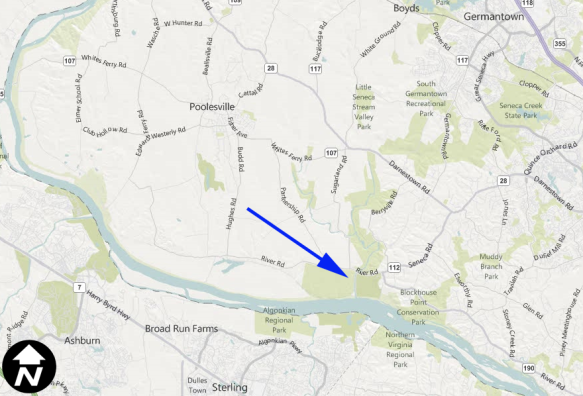AT&T Wireless and the International Monetary Fund want to build a Frankenpine in Germantown. The Montgomery County Planning Board earlier this month (Oct. 14) heard testimony in the case involving a proposal to construct a telecommunications facility dressed up like a fake tree on IMF property: The Bretton Woods Recreation Club. After reviewing the evidence and hearing from its attorney, the Planning Board unanimously voted that the AT&T application was incomplete.
Owned by the IMF, the Bretton Woods Recreation Club is located along River Road in Germantown. It is surrounded by sensitive natural landscapes and cultural resources, including rustic roads. The property has been identified by the IMF as an emergency relocation facility its staff and members could use in the event that the organization’s Washington, D.C., headquarters was threatened or inaccessible.
Because the IMF is covered under international treaties, i.e., the Bretton Woods Agreement Act, the organization is not required to comply with certain domestic regulatory frameworks when undertaking actions critical to its mission. In Montgomery County, most telecommunications facilities are reviewed under the Special Exception process in which applicants appear before the Board of Appeals and there is extensive community involvement. AT&T and the IMF in this case elected to pursue local regulatory approval through the Mandatory Referral process, a more streamlined approach.
AT&T, a wireless telecommunications carrier licensed by the Federal Communications Commission, proposes to construct a personal wireless services facility — e.g., antennas and related radio equipment — at the Bretton Woods property. To meet its engineering needs and comply with Montgomery County antenna collocation objectives that require carriers like AT&T to build structures that can accommodate the antennas and radio equipment of other carriers to minimize antenna and tower proliferation, AT&T proposed to build a 155-foot tower. To “conceal” the tower, AT&T proposed constructing a monopine: a tower with branches and bark.
Planning Department staff reviewed the AT&T proposal and recommended that the carrier use a less obtrusive design like a slim profile unipole with all of the antennas mounted inside the pole rather than on the exterior. The structure recommended by planning staff could be painted a non-reflective finish that would create a minimal contrast with surrounding vegetation at lower levels and the sky above the tree line.
Originally conceived as an attempt to make telecommunications towers more compatible with their surrounding environments, these structures have become integrated into popular culture because the tree towers — dubbed “Frankenpines” by some — create more of a visual impact than ordinary tower structures. While they are clever ideas, the towers often create more of a focal point than a traditional (e.g., monopole or lattice) tower and introduce visual elements into landscapes that in the long run create more of an adverse effect to surrounding landscapes than a traditional tower. By this I mean they are basically pigs with lipstick — you still know it’s an out of place pig — and you’re more likely to stare at it longer than something that’s not all gussied up.
Frankenpines are one type concealment technology used by the telecommunications industry. Other concealment or stealth strategies include fake rocks, signs, church steeples, and elevator bulkheads. Antennas — the critical part of any telecommunications installation — may be concealed or their visibility reduced by painting or by flush-mounting against buildings. They also may be hidden inside fake farm silos or inside existing buildings, hidden from view by radio frequency transparent panels that allow radio waves to pass through them.
The concept behind monopines is to prevent this:
Monopine proponents often seek this type of result:
But instead frequently are left with this:
Although the attorney representing AT&T and the IMF before the Planning Board attempted to convince the board that monopines like the one proposed are accepted and even ignored by most ordinary people who see them, anecdotal evidence, academic studies, and studies produced by telecommunications industry professionals all demonstrate that these structures do little to mitigate visual impacts to sensitive natural or cultural landscapes. In fact, they have become what one researcher calls phantasmagoria: towers that strive for reality by mediating between the necessity for towers to make mobile telephony possible while shocking viewers’ senses because the structures invariable are decoded — recognized — as fakes.
The cognitive processes that decode the monopines as fakes facilitate our popular culture’s appropriation of the structures. As a result, they have found their ways into visual arts, comedy, and even music: the New York City bluegrass band Frankenpine is perhaps the most accessible example of this. The band draws its name from a series of paintings by New York artist Peter Seward depicting Frankenpines. Websites, like fraudfrond.com, have sprouted alongside online photo albums depicting the towers.

The Lake George Frankenpine. Painted by Peter Seward, 2008.
The AT&T and IMF proposal will come back before the Planning Board later this year or early next year after the applicants have an opportunity to revise their proposal based on the comments received at last week’s hearing. Stay tuned. For additional information on these stealth facilities, see my earlier post on Frankenpines, Monopalms, and the Jolly Green Giant.
April 2015 Update:
Shortlink for this post: https://wp.me/p1bnGQ-m3










